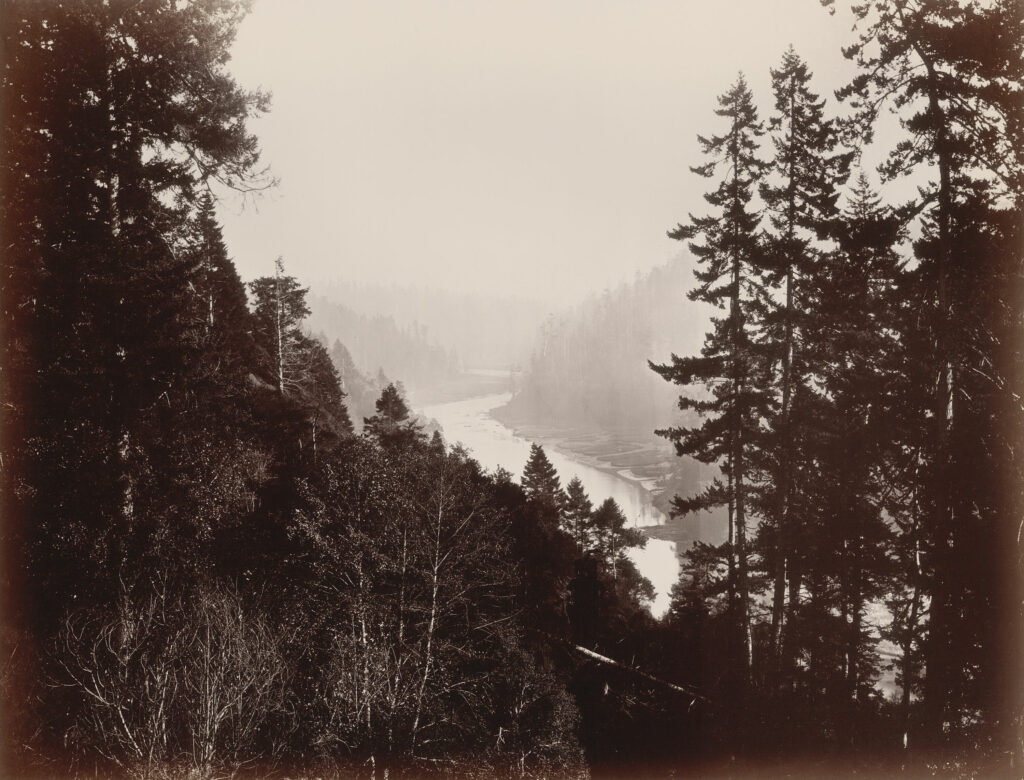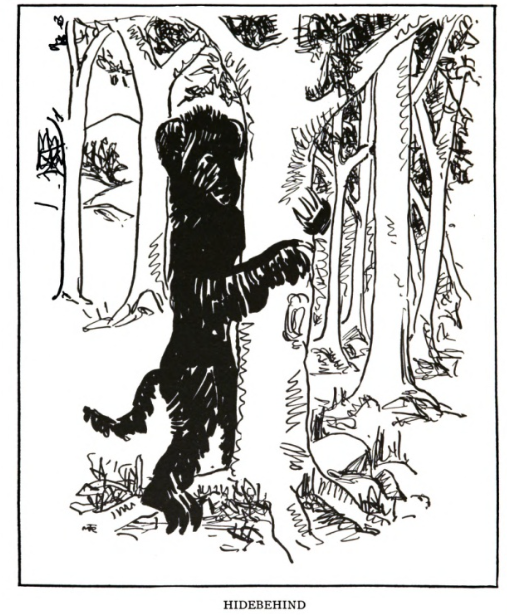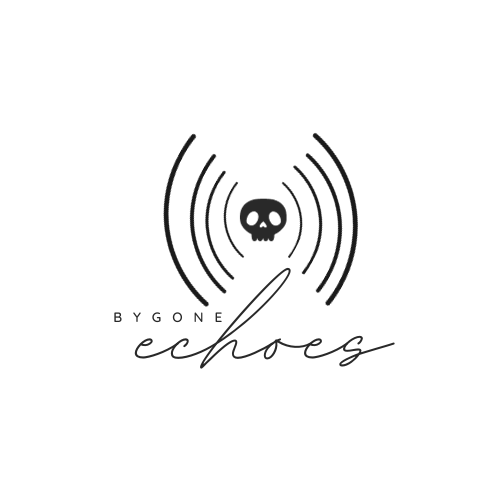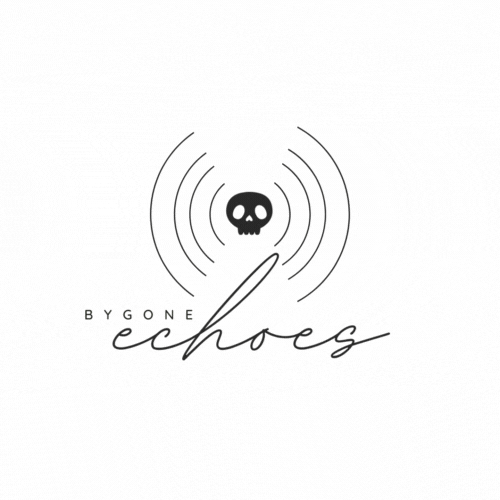Sylvan Phantoms: The Tale of the Hidebehind
Ever felt a shiver down your spine while walking through a dense forest? Maybe it was just the cold… or perhaps it was the Hidebehind, one of America’s spooky folklore creatures, a cryptid waiting in the shadows! This beast has been the subject of campfire stories and hushed whispers in lumber camps across the U.S. for centuries. Remember, history isn’t just about the past; it’s about understanding how we got to now and where we might be heading next—and sometimes, what’s lurking just out of sight.

Original public domain image from Art Institute of Chicago
Whispered Frontier Warnings of the Hidebehind
In the early 19th century, the American frontier was not just a geographical boundary but a realm filled with mysteries and perils. As settlers and loggers pressed westward, penetrating deep into virgin territories, they encountered a world far more untamed than any they had known. Dense, expansive forests became the backdrops of their daily lives, places where the crack of an ax could be drowned out by the howl of unseen animals, or the rustle of something sinister flitting just beyond the periphery of vision.
This era of American expansion was underscored by both the lure of the wild and the fear of it. The Hidebehind emerged from this intersection of curiosity and caution—a spectral entity said to prey on those who ventured too far alone. This creature, capable of concealing itself behind the slenderest of trees, was whispered about as the cause behind the disappearance of unwary woodsmen, becoming a cautionary tale for respecting the dangers of the wilderness.
The logging industry, burgeoning in regions that would later be known as the Midwest and the Pacific Northwest, became a fertile ground for such legends. Campfires, around which loggers gathered after long days facing the very real dangers of their trade, often crackled with stories of the Hidebehind. These narratives wove themselves into the fabric of logger folklore, alongside tales of giants like Paul Bunyan, creating a rich tapestry of myth that served multiple purposes. They entertained, certainly, but also instilled a communal sense of caution, reinforcing the bonds among men who relied on one another for survival in a harsh and unfamiliar landscape.
Such stories did more than pass the time; they articulated the collective anxieties of a people confronting the unknown. In the tales of the Hidebehind, one can trace the contours of human fears—of isolation, of disappearance, of the unknowable wilderness—and how folklore serves to manage the psychological landscape of those living on the edge of civilization. The Hidebehind wasn’t just a monster; it was an embodiment of the frontier itself: vast, uncharted, and full of hidden dangers.

Fearsome Critters (1939)
A highly dangerous animal, but, owing to its intense aversion to the odor of alcohol, never known to attack an inebriate. One bottle of Uno beer has been proven to be a complete safeguard even in thickly infested country.
A biggish beast, standing about six feet and walking erect. The slender body makes it possible to hide completely behind the bole of a ten inch tree. The pelt is long thick, and black, and the tail is carried recurved. Looks like a French sheepdog’s. Almost impossible to tell whether the critter is going or coming, and practically hopeless to locate its face—if any. The short, well-muscled forelegs are equipped with grizzly-like claws.
Its food is chiefly intestines. Leaping from its hiding-place with a demoniacal laugh, it swiftly disembowels its victim with one swipe. Sometimes the fiendish howl frightens the prey to death before the blow falls.
The Hidebehind is never found in the open. He always conceals himself behind a tree trunk. His marvelously quick, stealthy gait makes it possible for him to stay constantly behind his prey, no matter how quickly the suspicious victim may spin about in the hope of glimpsing the marauder. The beast can go seven years without eating.
Fearsome Critters, / by Henry H. Tryon; illustrated by Margaret Ramsay Tryon
Call of the Unknown
While the Hidebehind might seem like a quaint relic of folktale, the essence of this creature echoes in modern “urban legends” and the portrayal of the unknown in media. The concept of an unseen terror that stalks unsuspecting victims taps into a universal human fear: fear of the unknown. Today, we see the Hidebehind’s descendants in the stories of Bigfoot and the Slender Man, creatures that also thrive in the gaps of our knowledge and sight.
The story of the Hidebehind also intersects with discussions about environmental conservation and respect for nature. Early folklore can be seen as a narrative tool for understanding and respecting the wild spaces that were—and are—vital parts of the ecosystem. The Hidebehind taught loggers and settlers to be wary of the vast, unexplored American wilderness, instilling a sense of caution and respect that underscored an early form of environmental awareness.
Cryptid Reminders of the Hideback
The legacy of the Hidebehind is not just in the stories passed down through generations but in the way, these tales encouraged a connection to the natural world, albeit through fear. These stories helped foster a collective identity among frontiersmen and provided moral lessons on the dangers of overstepping into nature’s bounds. The Hidebehind’s ability to permeate cultural boundaries shows its adaptability and enduring appeal in American folklore.
From shadowy forests to the shadowy corners of our imaginations, the Hidebehind remains an intriguing part of American folklore. As we explored this spectral stalker, we peeked behind the trees of history to understand a bit more about the fears and values of early American settlers. So, be kind, be curious, and be ready to make history—and maybe keep a little whiskey handy, just in case.
Interested in Learning More?
For those captivated by the eerie allure of the Hidebehind and other cryptic creatures of folklore, here are a few resources to deepen your journey into the heart of America’s forested past:
- Books:
- “American Monsters: A History of Monster Lore, Legends, and Sightings in America” by Linda S. Godfrey
- Fearsome Critters by Henry H. Tryon; illustrated by Margaret Ramsay Tryon
- TV Series: “Monsters and Mysteries in America”
- Websites:
- American Folklore americanfolklore.net
- Lumberwoods Unnatural History Museum http://www.lib.lumberwoods.org/
- Video Series: “Lore” on Amazon Prime, which delves into the dark corners of historical tales and folklore.

